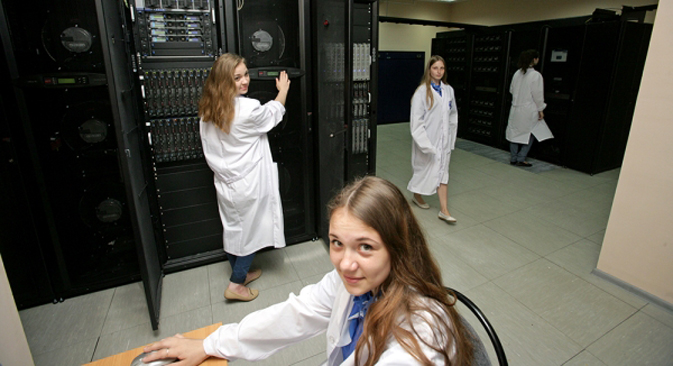'Virtual clone' will help to cure human beings

The Lobachevsky supercomputer. Source: Press Photo
With the help of a supercomputer, scientists from the Lobachevsky Nizhegorodsky State University have turned a collection of tomograms into a 3D model of a human being. Now doctors, without performing surgery, can enter a person and see any anomaly affecting him, even at the level of one of his cells. The development is extremely detail-oriented: for the "virtual" heart alone the mathematicians needed to take more than 50 million parameters into consideration.
Professor Vadim Turlapov from the Mathematical and Computer Faculty of the Nizhegorodsky State University said that until recently doctors had been using two-dimensional tomograms for making diagnoses. "When you then see a three-dimensional image of the patient, you get the feeling of a "virtual clone," although we still don't call the model by that name. It is a 3-D visualization of medical data".
Virtual anatomical lathe
A model of each specific patient is created for solving practical medical problems. "The 3-D reconstruction's main objective is to detect anomalies within the organism's bones, organs and tissues," said Turlapov.
The Lobachevsky supercomputer started working at the university in Nizhny Novgorod in 2014. Its peak capacity consists of about 600 teraflops (600 trillion operations per second). The computer is one of the largest supercomputers in the world. In Russia it is the second in terms of power (the first is located in the Lomonosov Moscow State University).
"We have created a system of anomaly measurements - their size, density and so on. These parameters help us determine the diagnosis and observe whether the sickness is progressing or regressing, and whether the medicine being used is effective or not."
Moreover, with the help of the Nizhegorodsky development, which has changed the meaning of the 3-D clone parameter, doctors can observe the behavior of a model, that is, how the organism will react to the types of cure.
"Usually the doctor needs a model that is not the full height of a body but rather just of some organ, for example, the region of the heart or the circulatory system," explains Turlapov. "We can create a model for studies, make a cut in any part and show the tissues that usually cannot be seen. Essentially, the technology performs the functions of a "virtual anatomical lathe."
Many companies have already tried creating tools with these functions, in particular, the American Anatomage. But the main aim of most of the technologies on the market is educational. The tool created by Russian scientists, on the other hand, has a practical, or rather diagnostic, aim - one to cure specific patients.
Clone in your tablet
Scientists from the Nizhegorodsky State University have already created a storage system for medical data on the Lobachevsky supercomputer and are ready to receive patients' tomograms for future visualization.
There already exists the technical possibility to make the 3-D visualization even for tablets or smartphones, which means that the patient himself can see his body or show it to any doctor. By using contemporary technology the creation of a "computer model" of a specific patient occurs very effectively: "The spiral computer tomograph can make a full tomogram of a body in ten seconds," remarked Turlapov.
With its broad application the Nizhegorodsky development will give any doctor access to 3-D visualization of medical data, and not just the specialist who is performing the tomograph.
"With time, by acquiring information on a specific patient, the computer will be able to detect the change of the organs' condition," says Turlapov. "The patient will then turn to a doctor with this information." In two-three years the scientists are planning to perfect the automatic diagnostic system on the 3-D human model. Therefore, the computer will not only "illuminate" the problem zone on the tomogram, it will independently make the diagnosis.
Read more: St. Petersburg University to map the Russian genome>>>
St. Petersburg State University has begun work on a data bank of genetic portraits of the peoples of Russia
All rights reserved by Rossiyskaya Gazeta.
Subscribe
to our newsletter!
Get the week's best stories straight to your inbox